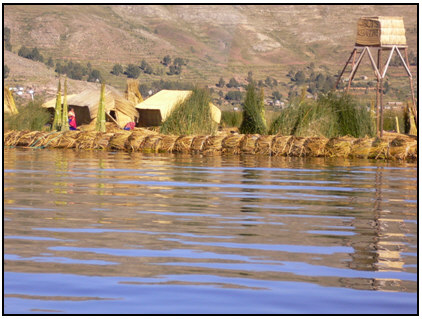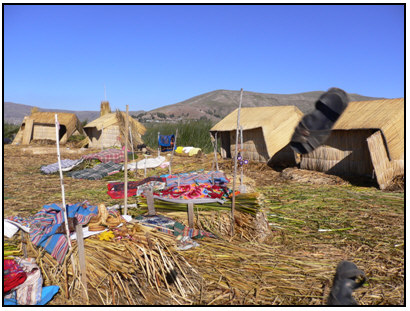

An Enchanting Tour of South Peru - Part 3
PART 3 - A. The Unique Floating Uros Islands
Floating Uros islands deserve a special mention because they are unique and they exist only in Lake Titicaca. These islands are man-made from totora reeds, a type of rush growing native in the shadows of the lake.

A floating island
The first of these floating islands were built more than five hundred years ago. The Uros Indians used to live on the shores of Lake Titicaca. However, when the Incas extended their empire to Puno, the Uros Indians, being peace-loving natives, withdrew onto the lake. They first lived in boats, also made from totora reeds, but soon learned the technique of building these floating islands.
The basic construction technique of these islands was demonstrated to us when we visited one in the morning on 19th April 06. The island we visited was not big, about 30 sq.m. in area and had six huts as dwellings for six close family members.

The bed or foundation of a floating island is made from the top layer of soil on which the reeds grow. Slabs of the soil including the dense reed roots measuring about 3x6 meters and a meter thick are first removed from the shadow bottom of the lake. They are tied together with ropes and wooden braces into a raft, which is buoyant. The dried reeds are then matted down and laid on to the raft to provide more buoyancy and a dry surface to work on. The island is anchored to the bottom of the lake.
However, the reeds rod very quickly so that new reeds must constantly be added to the top. The surface is uneven, thin and walking on it is likened to walking on a waterbed!
The island changes in size; more areas are created as the need arises. Also if a family decides to live separately, a portion of the existing island is sworn off so that he can live on his own.
The totora reed is the most important material to the islanders. With it they build their houses, boats, tools, fishing nets and souvenirs. The tender bottom of the reeds is even part of their menu!

A reed boat
Today there are about 40 floating islands protected within the Bay of Puno and are home to 2000 or so Uros.
The Uros continue their living by fishing, weaving and now, tourism. The fish they catch is similar to piranhas, which they eat and also sell them on the mainland. They also catch birds and ducks for eggs and food. They also rear guinea-pigs (Coys) for food. They are also known for their beautiful and intricate handwork, weaving, spinning and embroidery.
 |
|
| Piranha-like fish |
Dried cuys |

Colorfully dressed islanders
Life on the islands is hard and the islanders have to travel to the shores for fresh water. Many have left the islands and intermarried with the Ayamra and other Quechua-speaking Indians in the mainland.
The Uros tribe predates the Incan civilization. With their simply and poor lifestyle, the Incas thought them worth little and so left them alone. Yet the Uros, with their basic reed homes outlasted the mighty Incas with their huge stone temples and mountaintop enclaves!